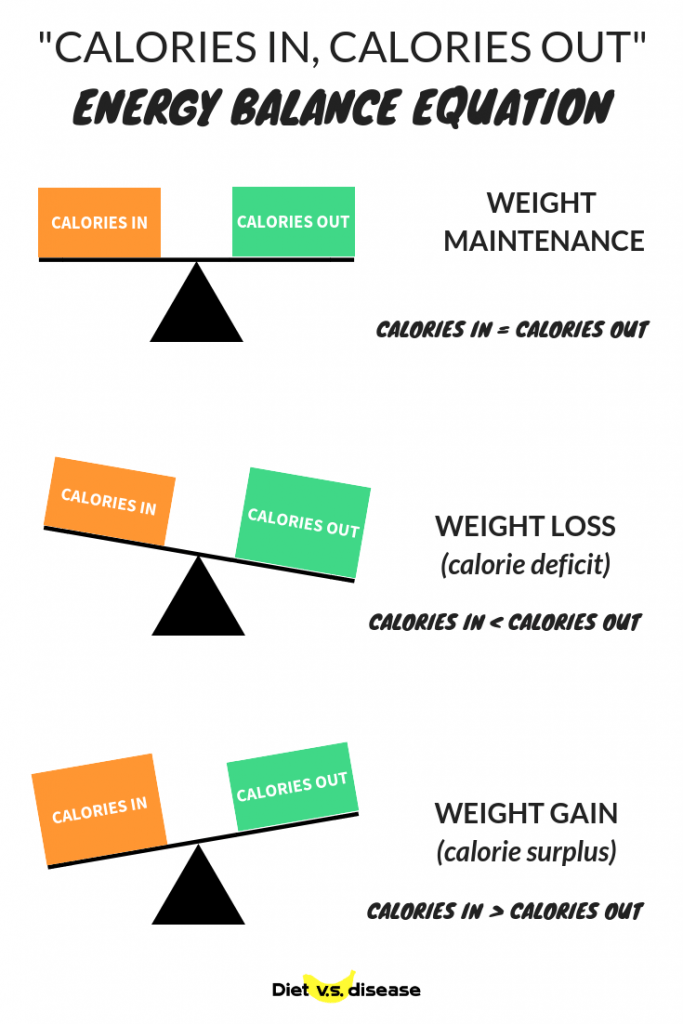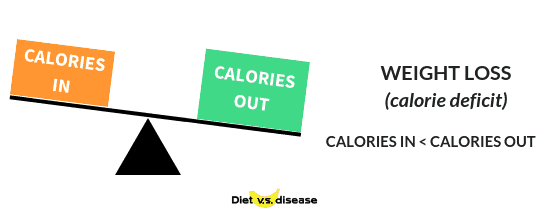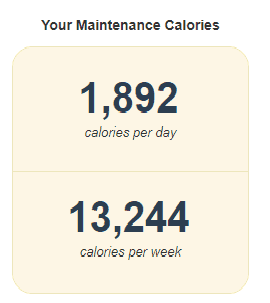Every cell in our body requires energy – measured in calories – to function.
We get this energy from food (calories in), and use it to power processes in the body during both rest and activity (calories out).
By tracking our calories in and keeping it lower than calories out, we can lose weight regardless of the type of food eaten.
This weight loss approach is nicknamed the CICO Diet.
Proponents are raving about how straight-forward weight loss becomes once you understand these principles…
But is that all there is to weight loss?
This article looks at the CICO diet in detail and whether you should try it.
What is CICO?

CICO (pronounced see-ko or kee-ko) is an acronym for “Calories In, Calories Out”.
It refers to how your body receives, uses and stores energy, also called energy balance.
Calories are simply the unit of measurement for energy (in Australia it’s kilojoules but it measures the same thing).
If more calories are consumed than used, they are stored as fat tissue (and we gain body fat).
If more calories are used than consumed, fat tissue is burned as additional fuel (and we lose body fat) (1, 2, 3, 4).
Put another way:
- Weight Loss: Calories in LESS than calories out (known as calorie deficit)
- Weight Gain: Calories in GREATER than calories out (known as calorie surplus)
- Weight Maintenance: Calories in EQUAL to calories out.
This diagram can also help you better understand the concept:

So it’s not possible to lose body fat without being in a calorie deficit.
And it’s not possible to gain body fat without being in a calorie surplus.
For Clarification
Just to make this clear, calories in refers to the food and drinks we eat.
Calories out refers to:
- our resting metabolic rate (energy used for normal bodily functions like breathing, sleeping, and just existing)
- non-exercise energy expenditure (NEAT)
- and exercise (physical activity) energy expenditure.
So calories out is not just your exercise levels.
Fun Fact: Every Diet in Existence Uses CICO
The reason any weight loss diet has ever worked is because it minimizes your caloric intake (calories in).
Assuming that calories out part of the equation does not decline as well, the result can only be a calorie deficit, and subsequent fat loss.

This is true of any weight loss diet you can think of:
- Ketogenic diet
- Paleo diet
- Weight Watchers
- Intermittent Fasting
- Military diet
- Atkin’s diet
- Vegan
- Detoxes and cleanses
- … and all the rest.
They might claim to work by cutting sugar, carbs, animal products or something particular from the diet.
However, in reality they work because they cut overall calories (whether we realize or not).
Summary: CICO is an acronym for ‘calories in, calories out’. It refers to the energy balance equation, a scientific principle that weight loss can only occur if your calorie intake is lower than your calorie expenditure.
What is the CICO Diet?

The CICO diet refers to a weight loss eating pattern where you regularly track your calorie intake.
You then ensure your numbers are consistently lower than your calories burned, and you’ll start to lose body fat.
So individuals are able to use CICO principles to shape their diet and lose weight (or gain weight if that’s their goal) without cutting out particular foods or food groups.
How is it Done?
The first step is to calculate how many calories your body needs to maintain your current weight.
This number is often referred to as your total calorie requirements or your total daily energy expenditure (TDEE).
This number depends on your weight, age, height, activity levels and more. Fortunately, you can easily do this with an accurate calorie calculator (like this free one).
Once your TDEE is calculated, you then decide how much weight you want to lose each week and figure out the calorie deficit you need.
As a loose rule of thumb:
- 250-calorie deficit per day = 0.5 lbs fat loss per week
- 500-calorie deficit per day = 1 lb fat loss per week
- 1000-calorie deficit per day = 2 lbs fat loss per week
Or we can (and should) look at it per week:
- 1750-calorie deficit per week = 0.5 lbs fat loss per week
- 3500-calorie deficit per week = 1 lb fat loss per week
- 7000-calorie deficit per week = 2 lbs fat loss per week
Once you start to learn your numbers you’ll realize that it’s much more enjoyable (and realistic) to aim for a 1750-3500 calorie deficit per week maximum.
An Example of Calculating Calorie Requirements
Let’s do an example:
- 55 year old woman
- Weighs 165 lbs (75 kg)
- Height is 5’7” (170 cm)
- Does some light exercise (1-2 days per week) such as walking.
Using the calorie calculator mentioned above, we learn that to maintain her current weight she requires 1892 calories per day, or 13244 calories per week.

If she aims to lose 0.5 lbs per week (equal to 13 lbs over 6 months) – without increasing activity levels – then she can calculate it like this:
13244 (her TDEE) – 1750 (calorie deficit for the week) = 11494 calories per week.
Now she knows if she stays around 11500 calories per week (about 1600 calories per day) she will lose weight.
If she doesn’t cut her calories below her TDEE, the only other way to lose weight would be to increase her activity levels.

However, it’s much more difficult to burn additional calories vs consuming fewer calories. Of course, doing both is ideal.
Tracking Calorie Intake
Lastly, you need to track your calorie intake each day.
Otherwise there’s no way to know if you are hitting (or exceeding) your calorie goals.
This means accurately documenting every thing you eat and drink each day, including quantities.
You can do this easily with an app such as MyFitnessPal or LoseIt. They’re both free to use and have enormous food databases, which makes it much easier.
Remember, if you are in a calorie deficit you will lose weight. If you are in a calorie surplus you will gain weight.
Summary: The CICO diet is an eating pattern based on accurately tracking your calorie intake. This number can then be compared against the average calories you burn to determine if you will gain or lose weight.
The Benefits of a CICO Diet
There are many benefits of following a CICO diet:
1. There Are No “Forbidden” Foods

Do you love a sandwich? Eat one.
Enjoy cow’s milk? Feel free.
Crave a treat at afternoon tea? Go for it.
Once you know your numbers, this diet is very straight forward.
There is no list of rules or restrictions that you need to memorize like with other popular diets.
You can still eat your favorite foods too without feeling guilty, so long as it falls within your daily calorie goals.
2. It’s Eye-Opening

Very few people actually know the number of calories in the everyday foods they eat.
For example, the calories in a cappuccino, a banana, a square of chocolate, or their favorite pasta dish.
Tracking calories can be a real eye-opener, especially when you see the amount of calories in junk food and average restaurant meals.
Counting calories may also encourage you to track calorie expenditure, such as wearing a Fitbit or using a movement tracking app.
Many people are disappointed when they learn just how little calories are burned with exercise.
3. It’s Free and Quicker Than Ever

Everything you need to get started with CICO is free.
Calorie tracking apps offer paid upgrades options, but their free versions are definitely adequate.
The apps have also made calorie counting quicker and easier than ever before… no more notepads and calculators.
4. It’s Guaranteed To Cause Fat Loss

If you track your calories in vs calories out and consistently remain in a calorie deficit, you will lose body fat.
Guaranteed.
Summary: The CICO diet does not restrict any foods or food groups, it teaches you the calorie content of everyday foods, and it’s guaranteed to help you lose weight if done correctly. It’s also never been easier to track your calories with free apps.
Problems with the CICO Diet
There are several issues with the CICO diet:
1. The Focus Is On Numbers, Not Healthy Food

This diet can be unhealthy in the long-term if you don’t pay attention to where your calories come from.
This is because you can still lose weight while eating unhealthy foods (as long as you are within your calorie limit).
For example, one man exclusively ate McDonald’s for 90 days in a row and lost 37 pounds (17 kg).
The reason being he capped himself at 2000 calories per day, which was a large enough calorie deficit for him to lose weight (his TDEE was much higher than 2000 calories).
Of course, if he was to continue eating like that for years, he’d be a high risk for nutrient deficiencies and related issues given that McDonald’s is not nutritious food.
Many critics of CICO focus on this fact, but if you follow a CICO diet and eat a nutritious food, this point is moot.
2. Tracking Becomes a Pain

Counting calories doesn’t require much math these days as we have access to free apps like MyFitnessPal and LoseIt.
However, logging food every single day can still become tiring after a few weeks.
That said, given several apps have enormous food databases, are always in your pocket, and are free to use, it’s never been easier to track your intake.
3. Not Appropriate For Those With a History of Eating Disorders
Those with a strong emotional relationship with food or a history of eating disorders should not count calories.
Emphasizing numbers can further encourage an unhealthy mindset in certain individuals.
Summary: The main problems with the CICO diet is that you can still eat junk food if you wish, tracking calories every day is tiring, and it’s likely not a good idea for those with a history of eating disorders.
Aren’t Carbs To Blame For Fat Gain?
No, carbohydrates do not make you gain weight independently of a calorie surplus (5, 6).
In other words, carbs can only contribute to weight gain if you consume excess calories overall.
I have written about this extensively here.
What Are People Saying About CICO?

The CICO diet first gained traction on the online forum Reddit.
There are hundreds of weight loss success stories there. Here are some recent examples:
- One man lost 250 lbs (113 kg) and was able to cancel his weight loss surgery.
- Another person has now lost over 300 lbs (136 kg) in 536 days. He said, “This morning I got on the scale and cried when it told me my weight. I weigh 301.2 lbs… While to some of you that is still over weight to me this is the lowest I have weighed since maybe my first year of college.”
- This Redditor said, “CICO is not as scary or emotional as I thought it would be. Any one else have a “I’m shocked this works” moment?”
- One person explained how CICO has helped shift their mindset, “I’ve said no to pretzels two evenings in a row. NEVER thought that could happen, even as recently as last month. It’s not a permanent “ban” — I’m aware that could cause backlash and bingeing. No, it’s a “I’ll have them again when I deem the time is right, when it fits my overall plan.” Not sure how the switch flipped, but if only all of life was so easy.”
- This person explained why he/she could not lose weight on CICO despite “doing EVERYTHING right.” They went on to say, “But I wasn’t being honest with myself. I’d estimate the weights of things, downplay how big of a portion I had, not log my cheat days or meals, and not include things like sauces and cooking oils. I don’t think you can find success with CICO until you’re absolutely ready to be completely honest with yourself.”
Creating CICO Diet Recipes and Snacks

A few simple tweaks to cut the calories in your favorites can go a long way with CICO.
Here are some suggestions to help you meet your calorie goals:
- Cooking Oil: Many believe that most of the oil remains in the pan after cooking. But in reality your food does absorb most of the oil. Instead you can use small amounts of spray oil for cooking, just enough so the food won’t stick.
- Sauces and Dressings: These contain the hidden calories that most of us don’t account for. Use balsamic vinaigrette, lemon juice, tzatziki or mustard.
- Drinks: Water is the best choice of course, but artificially-sweetened (“diet”) drinks are zero calories as well.
- Dark Chocolate: If you absolutely must have your chocolate, learn to eat dark chocolate (85% cocoa). Because of the high cocoa it is not as “more-ish” as milk chocolate.
- Bolognese: Add a bean mix with your mince when cooking Bolognese sauce. This way you can eat the same volume of food but less calories (and more fiber).
- Ice cream: These days there are low-calorie ice creams available, they contain artificial sweeteners.
- Breakfast or Snack Swap: Consider a low-carb protein shake for breakfast or as a low-calorie snack when you first start out. If you purchase a tin of protein powder it works out very cost-effective.
- Chips/Fries: Pre-made frozen foods that you bake such as wedges, hash browns etc., are very high in oil and calories. Cut up your own potatoes into wedges and bake them with a light spray of oil and seasoning.
For more weight loss strategies you can easily implement, we have 77 proven strategies here.
Should You Try The CICO Diet?
The CICO diet (short for calories in, calories out) is an eating pattern where the individual regularly tracks their calorie intake.
This is easily done with free apps like MyFitnessPal or LoseIt.
So long as calories in remains consistently less than calories out, you’ll start to lose body fat.
In fact, every weight loss diet, including Atkin’s, keto diet, Paleo, intermittent fasting, and the 1200-calorie diet all work by cutting your calorie intake.
The CICO diet allows you to achieve that same calorie deficit as these diets, but without forcing you to cut out entire food groups or skip meals.
This allows you to still enjoy your favorite treats over the holidays – without the feelings of guilt – while learning to be more aware of your portion sizes.
On the flip side however, tracking your calories can still become tedious, even if it is streamlined with an app.
So if you’re not disciplined enough to take daily action and track calories, if numbers freak you out, or if you have a history of eating disorders, then CICO is likely not the right step for you.
Ultimately, all these different diets give you one piece of the weight loss puzzle, but not the entire process.

In my decades of diet and health research, I’ve found that for most, CICO is better as an observation than a goal. Why? Because the way most people cut calories or burn more calories ends up adjusting the “calories out” in unexpected ways.
For instance, I spent my 20s eating very low-fat, very high-whole-grain, and overall (not realizing it) very low-nutrient, while doing 5 hours of high-intensity cardio every week. Result? I crashed my thyroid and adrenal health, resulting in a 30 year old who couldn’t get off the couch most days. My body went into something akin to starvation mode, forcing a drastic reduction in energy expenditure that my even my intensely strong will power couldn’t overpower. My appetite also went through the roof, and I had food cravings (especially for high-reward and high-calorie food combinations) 24/7 that I could ignore and ignore and ignore until I would suddenly realize I had just eaten an entire cookie cake or whole box of granola in 10 minutes and have no idea how to undo the calorie damage that had just occurred.
I’m now 42 and working on conditional CICO. I’ll reduce calories, but ONLY as long as I keep my micronutrients above the RDA in every category. I’m using Cronometer instead of MFP because it tracks all micros as part of its free plan. Doing this, I’ve been able to choose foods to fill in the gaps I had, and once regularly hitting all the targets, I looked at which foods were least nutrient-dense and started reducing those, and only those, till I had a 200 calorie deficit daily. The biggest thing I did was remove sugar entirely, because (like an alcoholic) I can’t do it in moderation, at all. A month after that last step, I finally started losing weight at a 1/2 to 1 lb weekly rate, with no hunger, an extremely varied diet, and an *increase* in energy and overall health. I’m 6 months in and this is working better than anything I’ve ever tried. I even have the energy to work out 3x/week (and it’s Crossfit, at that!), something I haven’t been able to do regularly for over a decade.
My overall diet is 90% paleo, with occasional rice, corn, dairy, and even more occasional treats with very small amounts of maple syrup or honey. The composition is *really* important, because I can’t maintain the “calories in” portion at the level I need to *and* maintain good health (including a good metabolism and good energy) unless every calorie is nutrient-dense.